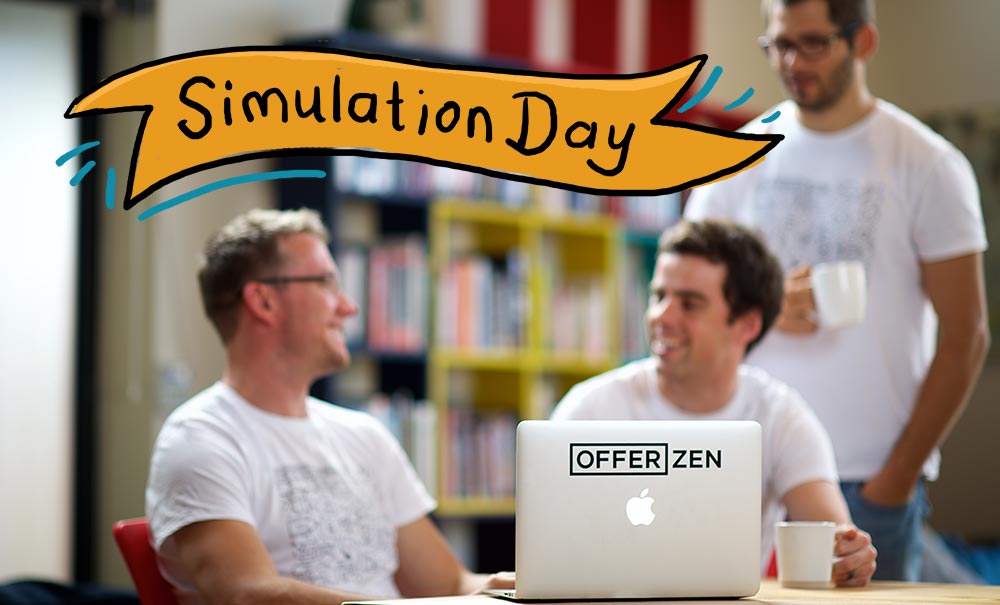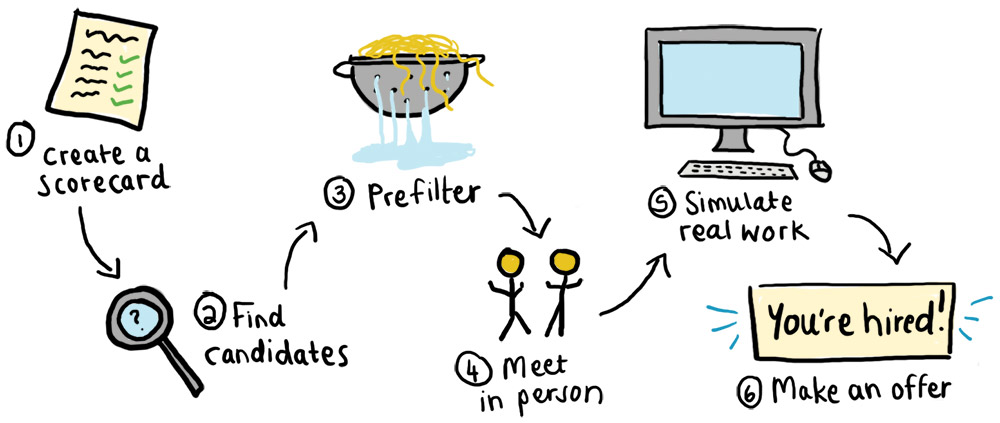In the past twelve months the OfferZen team grew from 5 to 17. Hiring was slow at first, but then we added 9 new team members in 3 months.
At the time we had no hiring process, and our first few attempts were unfocused. Soon we realised that if we wanted to succeed and survive as a company, we had to figure out a workable hiring process. Fast.
Although we haven’t perfected the process, we have a strong method now. We’ve added great people to the team who fit their roles and enjoy what they do.
One person takes charge
There is one early hiring meeting I remember particularly well. Three of us were having an informal chat with someone at our offices. Towards the end of the chat she asked a question that made us realise the confusion we’ve caused: after a 2 hour chat she didn’t know if we had a position we’re hiring for, or if we were simply having coffee.

After that incident we made one basic decision: identify one person to take charge of the hiring for a specific role.
“Identify one person to take charge of the hiring for a specific role.”
In our team, the founders don’t take direct responsibility for hiring. We also don’t have an HR person or team who handles hiring for the whole company.
A dedicated person helps us focus on our primary hiring maxims:
- Move fast.
- Avoid going into “half-hiring” mode.
- Make time to immediately pursue a promising candidate.
Create a scorecard
Up until that time we mainly worked on our core product and processes. But to grow the team, we had to start thinking hard about roles and who we need to fill them.

Creating a good “scorecard” is the first step of our process. The concept comes from the book, Who by Geoff Smart and Randy Street. The “person in charge” takes the lead on the scorecard, but we also get at least 2 other teammates to give input.
Our scorecards have 4 sections - 3 from Who, and 1 we added:
-
Mission: What is the high level “goal” of the job? It tends to be pretty hard to write this. And even harder to keep it short.
-
Outcomes: What is the definition of success for the role? Or: What will the world look like if the job is perfected? The outcomes need to be clear, measurable, and focused on the important things.
-
Competencies: What skills are required to do the job?
-
Background and personality: It's hard to evaluate personality early in the process, but we've found that looking for hobbies and interests is often a good proxy.
“We find it super useful to finalise the scorecard before we reach out to any candidates.”
We find it super useful to finalise the scorecard before we reach out to any candidates. Our main screw-ups have happened when we weren’t sure why we were hiring someone and what we wanted them to do. In those cases we jumped into sourcing and interviewing candidates without knowing what we wanted and wasted a lot of time.
That being said, by talking to candidates we do learn about the roles we have in mind. On a few occasions we’ve changed our minds and scorecards after talking to someone.
Finding candidates
We’re generally aware that different roles require different sourcing strategies. We use OfferZen to find developers, for example :-)

We mostly start by adding a job post on our online careers page. The online job description is slightly different to our scorecard. We think of it more as a sales document. It focuses on attracting people and explaining the role to them even if they know nothing about OfferZen.
We also just talk to people we know a lot, and we’ll share the info on social media. Scanning lists of contacts on Facebook or LinkedIn is useful too.
Meeting candidates
When meeting candidates, we keep in mind that hiring is about balancing 2 things: evaluating the candidate and selling the job.

It’s as bad to focus too much on selling the job as it is to postpone it for too long. We sell only the next step of the process at any given time. This prevents us from overcommitting to a candidate too early, or missing out on them.
Our engagement with candidates has 3 basic steps:
- Pre-filter
- In-person chat
- Simulation
1. Pre-filter
The goal for pre-filtering is simple: do we want to have an in-person chat with the person or not? When our scorecard is good, this phase is usually quick and easy... but only if we don’t cheat by pursuing candidates that are not plausible for the specific role.
Our golden rule is: trust the scorecard and make sure the person fits all the requirements. If they don’t, we require persuasive reasons for “letting them through.”
2. In-person chat
If we want to meet someone, we do it as soon as possible. If this means driving two hours to meet the person, we do it. If it means seeing them on a Saturday afternoon, we do it.
We talk candidates through the scorecard in detail, and explain what our expectations are.
“We talk candidates through the scorecard in detail, and explain what our expectations are.”
The in-person chat has 2 goals:
- Get a better understanding of someone’s abilities, interests and motivations.
- Ensure that they understand the role and are interested in it.
After an initial chat, we’re not always sure whether we want to pursue it further or not. We’ll then try to have another chat with them before committing to the next step. It always helps to take another member of our team with.
3. Simulation
The third step is simulation. The candidate comes to our office for 1 or 2 days and does real work with the team. This is the best way for us to determine whether someone is a good fit and gives the person a good idea of what it is like to work with the OfferZen team.

The goal of simulation is to match specific tasks to specific competencies on the scorecard. We’ve found that planning in excruciating detail is important if we want to get this right in 1 or 2 days. We compile a very detailed document pack, and share it with the candidate in advance.
If you’re interested, you can see how we approached our simulation day for hiring a UX designer.
The cost of this approach is high. It takes a lot of time and energy from the rest of the team. The good news is that a team can get better at this. Over the past few months we’ve gotten more used to doing simulations on a somewhat regular basis.
Simulation days are also risky. Candidates talk to real clients and work on real product features. If they mess up, it hurts us.
Although this part of the process is tough on everyone, simulation makes it super obvious to us if we want to hire someone. Once we've made a decision to hire someone, we make an offer right away.
“Once we've made a decision to hire someone, we make an offer right away.”
What if we don’t want to take it further with someone?
We aim to communicate promptly and honestly with all applicants.
In the pre-filtering phase we respond via email to let people know if we’re not taking it further with them.
If we’ve engaged with someone in person (even via Skype or telephone), we’d call them to discuss our decision.
Our process, in short
We put one person in charge, and this is what they do:

Read more
- The Ultimate Developer Hiring Guide. This guide covers every aspect of the tech hiring process, from sending the first message, to interviewing and onboarding developers.
